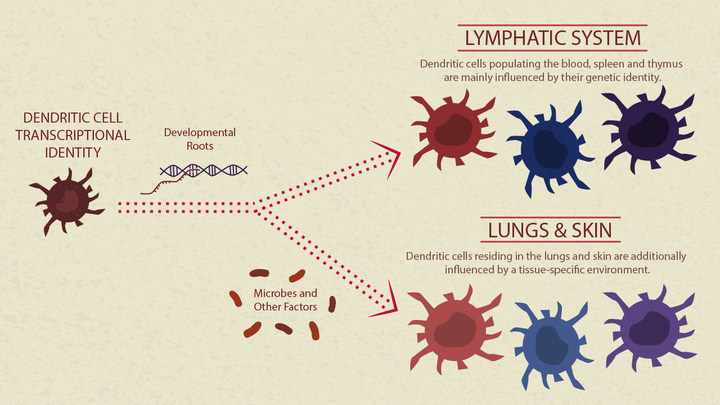Guards of the human immune system unraveled

Dendritic cells in lymphatic tissues are mainly influenced by their genetic identity, while in lungs and skin dendritic cells are predominantly affected by tissue-specific factors. © Carla Schaffer / AAAS
Dendritic cells – their name is derived from the large amount of dendrites on their cell surface – populate most parts of the human body. There they act as guards by recognizing, engulfing, and processing foreign pathogens.
Finally, those dendritic cells migrate to nearby lymph nodes, where they interact with other immune cells to trigger a pathogen-specific immune response. Consequently, dendritic cells play an important role within the complex immune system. In recent years, it became evident that in the mouse dendritic cells are composed of different subtypes, which differ in function and distribution across the body. In contrast, less was known about the corresponding situation in humans.
Recently, Dr. Gordon Heidkamp and Prof. Dr. Diana Dudziak from the University Hospital Erlangen performed a global study, which, for the first time, systematically characterized dendritic cells in different human organs such as blood, spleen, thymus, tonsils, bone marrow, cord blood.
Using 16-color flow cytometry, they detected different dendritic cell subtypes, determined their distribution across the various organs and identified important cell surface proteins. As a result, the scientists revealed that the surface profiles of dendritic cells of the same subtype are constant throughout the different tissues.
Additionally, the scientists from Erlangen isolated dendritic cells from human blood, spleen, and thymus and analyzed their genetic information in the form of ribonucleic acid (RNA). The complex data analysis was performed in close collaboration with Jil Sander and Prof. Dr. Joachim L. Schultze from the LIMES Institute of the University of Bonn.
Using innovative methods, for example Cibersort analysis, they were able to imposingly demonstrate that the different subtypes share a constant profile, regardless of their initial location. Prof. Dr. Schultze: “In contrast, our data further demonstrate that within non-lymphatic organs such as lungs and skin, tissue-specific signals have a higher impact on the transcriptional output of dendritic cells.”
According to these recently published findings and due to the special characteristics of dendritic cells, the scientists expect substantial impacts on the therapy of immune diseases as well as on the development of new approaches to treat tumors. Prof. Dudziak summarizes: “There is evidence that dendritic cells might play a crucial role for the development of innovative therapies targeting the immune system. Our results help to understand the fundamental characteristics of dendritic cells.”
The study was conducted in a close collaboration between Dr. Gordon Heidkamp and Prof. Dr. Diana Dudziak from the University Hospital Erlangen and Jil Sander and Prof. Dr. Joachim L. Schultze from the LIMES Institute of the University of Bonn. The latter are members of the excellence cluster ImmunoSensation. In total, 31 scientists were involved in this project, located in Erlangen, Bonn, Kiel, Bamberg, Augsburg, Frankfurt, and Singapore.
Publication: Human lymphoid organ dendritic cell identity is predominantly dictated by ontogeny, not tissue microenvironment, „Science Immunology“
Contact for media:
Prof. Dr. Joachim L. Schultze
LIMES Institute (Life and Medical Sciences)
Genomics and Immunoregulation laboratory
Phone: +49(0)228/7362787
E-Mail: j.schultze@uni-bonn.de
Prof. Dr. Diana Dudziak
Universitätsklinikum Erlangen
Department of Dermatology
Laboratory of Dendritic Cell Biology
Phone: +49(0)9131/8539346
E-Mail: diana.dudziak@uk-erlangen.de
Media Contact
More Information:
http://www.uni-bonn.de/All latest news from the category: Life Sciences and Chemistry
Articles and reports from the Life Sciences and chemistry area deal with applied and basic research into modern biology, chemistry and human medicine.
Valuable information can be found on a range of life sciences fields including bacteriology, biochemistry, bionics, bioinformatics, biophysics, biotechnology, genetics, geobotany, human biology, marine biology, microbiology, molecular biology, cellular biology, zoology, bioinorganic chemistry, microchemistry and environmental chemistry.
Newest articles

Superradiant atoms could push the boundaries of how precisely time can be measured
Superradiant atoms can help us measure time more precisely than ever. In a new study, researchers from the University of Copenhagen present a new method for measuring the time interval,…

Ion thermoelectric conversion devices for near room temperature
The electrode sheet of the thermoelectric device consists of ionic hydrogel, which is sandwiched between the electrodes to form, and the Prussian blue on the electrode undergoes a redox reaction…

Zap Energy achieves 37-million-degree temperatures in a compact device
New publication reports record electron temperatures for a small-scale, sheared-flow-stabilized Z-pinch fusion device. In the nine decades since humans first produced fusion reactions, only a few fusion technologies have demonstrated…





















